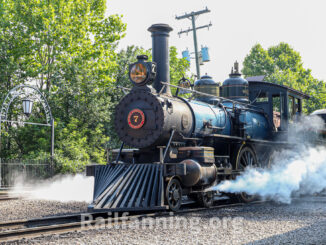
In the early morning hours of July 28, 1869, the No. 2 express train, pulled out of Paris, Tenn., en route to Louisville with Eugene Riley at the throttle.
Around 10 p.m., passengers retired for the evening. What happened next in the early morning hours 100 years today was the subject of considerable debate.
According to some accounts, the train began to speed, though the train’s conductor later disputed that assertion, saying the train was running its usual 15 miles per hour for that section of track.
Two passengers from New Orleans — Mr. Doll and Mr. White — arose, dressed and inquired as to what the problem might be. Another passenger awoke to the sound of “the engine blowing on brakes” followed “by a rattling noise similar to that made by drawing a stick quickly across a picket fence,” according to a July 19, 1869, report in the Louisville Evening Express.
By about 1 a.m., it was running just two minutes behind schedule as approached the crossing at Budds Creek. “In crossing the bridge and trestle … the greater part of the structure gave way and precipitated the whole train into the valley or bed of the creek,” one newspaper account read. The plunge set fire to the train’s cars, which consisted of six cars, including a baggage car, an express car and one or two sleeping coaches.
In total, the wreck left five people, including two railroad employees, dead and more than two dozen injured. The tragedy garnered a considerable number of headlines in newspapers nationwide, including publications in Pennsylvania, Kansas and Mississippi, and as even internationally in England.
The Victims
Among those killed was Hugh McColl, a native of Scotland who moved to New Orleans 25 years earlier. The esteemed merchant and his wife, Susan, and son, Norman, were traveling east “on a tour of pleasure.” McColl was laying “in his berth” in a car at the rear of the train when the train crashed. A piece of the coach’s timber crashed down on him, killing him and severely wounding his wife, who died on August 2 from injuries sustained in the wreck.
In the locomotive, steam escaping from the damaged boiler killed engineer Riley and fireman Charles Shields. Following the wreck, workers found the badly burned body of a man in the wreckage. At least one report identifies the passenger as Thomas Shields, while another report identifies the other victim as Thomas Baxter.
Charles A. Brown, the train’s baggage master was discovered buried under fallen timbers, baggage and freight, including several boxes of peaches. Initial reports listed express manager John C. Dugan as fatally injured. A subsequent account, however, said he was badly wounded. An even later story revealed he “is not dead. He is doing well.”
Amid the carnage and chaos, stories of heroism emerged. Conductor Matt Lowe calmly and coolly helped passengers from the wreckage. Frank W. Carney, a passenger and son of former Montgomery County resident H.P. Carney, similarly jumped into action “with an almost superhuman effort” to aid fellow injured passengers.
Suspicions
An estimated $100,000 was in the train’s safe at the time of the wreck. Initial reports indicate responders did not immediately locate the safe but found it a couple of days later “red hot and unopened when found, but of course its contents were totally consumed.” Mailbags destined for Louisville, Cincinnati, Philadelphia and Buffalo, New York, were destroyed during the crash.
A few days after the wreck, a correspondent for the Cincinnati Commercial, who coincidently rode over the spot of the crash four days before the tragedy, returned to the scene to inspect it. The writer questioned many of the facts that some publications printed, including whether the bridge was built following the war.
Despite his speculation, the writer seemed unaware of the December 7, 1866, wreck in roughly the same location. Curiously, the writer also indicated the $100,000 of specie — or coins — allegedly on the train was in fact not on board at the time of the crash. Regardless, the reporter may have been snooping in the right direction.
Authorities on July 30 arrested a “train-boy” named Josh Nolan. Following the wreck, Nolan, who arrived at the scene of the wreck on the second train, went into one of the wrecked sleeping cars to procure blankets and pillows to help aid wounded passengers.
Shortly before retiring for the evening, Judge H.C. Caulkins of New Orleans, traveling with his wife and two children, placed his gold watch and about $1,000 in one of the “sponge pillows.” When he ran into the train, Nolan allegedly grabbed the pillow containing Caulkins’ watch and money. He pocketed both the money and the watch.
Another railroad employee later saw Nolan with the pocket watch and reported it to the judge, who confirmed the watch was indeed his. Nolan, regarded “as an upright, honest lad, and was much esteemed by his associates on the railroad,” apparently tucked the money into the folds of his pants, necktie and collar.
He was later released after evidence could not be corroborated.
The Aftermath
In September 1869, F.O. Anderson, the assistant attorney general served summons on several Memphis, Clarksville & Louisville employees and officers. By November 1869, an investigation cleared the Memphis, Clarksville & Louisville of any wrongdoing in the wreck, and later testimony blamed defective rolling stock belonging to the Louisville & Nashville for the wreck, but the Louisville & Nashville charged the Memphis, Clarksville & Louisville between $25,000 and $30,000 for its losses in the tragedy.
Not unlike modern-day mishaps, the Budds Creek calamity resulted in various lawsuits, including one from J.J. Buck against the Louisville & Nashville seeking $10,000 in damages for his injuries. A 10-day trial in 1874 ended in a mistrial with the jury divided six to six. A Louisville bank also filed suit over money it lost in the wreck.
However, like so many stories that at one point garnered headlines, the Budds Creek railroad disaster eventually faded from the pages of newspapers.






1 Trackback / Pingback
Comments are closed.